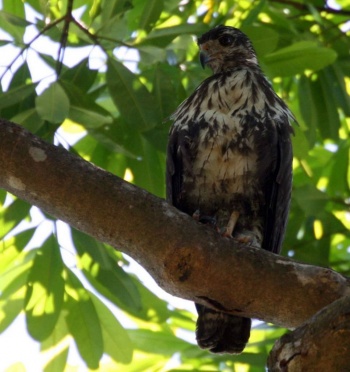- Buteogallus anthracinus
Includes: Mangrove Black Hawk
Identification
Length 50-58cm (20-23"), wingspan 122-127cm (48-50")
As the name implies, this is a very dark hawk; dark brown to almost black, with a yellow bill tipped in black, and some white spotting on the base of the primary flight feathers, and at the tip of the tail.
In its limited US range, it is most easily identified by chunky shape and broad white band crossing middle of tail.
Compared with Great Black Hawk, skin of cere generally brighter yellow and extends beneath the eye. Lacks fine barring on the thighs (tibials) which may be present in Great Black Hawk (esp. Central America).
Shorter tail means wing tips almost meet its tip but longer primary projection than Great Black Hawk. Dark rump
Variation
Notice the variation: width of the white tail band varies geographically.
Similar species
Further south compare the Great Black Hawk and the rare Solitary Eagle.
Distribution
Found in coastal regions of northern and north-western South America, incl. Trinidad & Tobago, north through Central America and Mexico, to southernmost USA (Arizona and Texas). Generally resident, but some local movements, and only a summer visitor to south-eastern Arizona. Also seen along border section of Rio Grande River, notably in Big Bend NP, in winter. Very rare visitor to lower Rio Grande Valley, Texas.
Conservation Status
Overall common and widespread. In its limited US range it is rare and local, with an estimated 250 breeding pairs remaining.
Taxonomy
Recent evidence has led the population on Cuba to be considered a separate species, the Cuban Black Hawk (Buteogallus gundlachii). However, the Mangrove Black Hawk (B. subtilis including subspecies rhizophorae and bangsi) is now included in Common Black Hawk as three subspecies.
Subspecies
Clements recognizes these subspecies[1]:
- B. a. anthracinus:
- South-western US to northern South America, including Yucatan, Cozumel Island and islands in Gulf of Honduras, St. Vincent and Trinidad
- B. a. rhizophorae:
- Pacific coast of El Salvador and Honduras
- B. a. bangsi:
- Pacific coast of Costa Rica and Panama; Pearl Islands
- B. a. subtilis:
The formerly recognized subspecies B. a. utilensis is now considered a synonym of anthracinus.
Habitat
Wide range of wooded habitats, especially in coastal areas. In the northernmost parts of its range, nests most commonly in cottonwood trees in riparian areas.
Behaviour
Gentle and lethargic except while nesting, when it often drops out of the skies from great height.
Breeding
They build a large stick nest in a tree, and usually lays one dark-blotched whitish egg. Will abandon nest if disturbed too much.
Diet
They have a very varied diet but fish and reptiles are very important to them. Dietary items include crabs, small vertebrates and eggs.
Gallery
Click on photo for larger image
rka}}
Sudama Steps, Trinidad, October 2018
References
- Clements, J. F., P. C. Rasmussen, T. S. Schulenberg, M. J. Iliff, T. A. Fredericks, J. A. Gerbracht, D. Lepage, A. Spencer, S. M. Billerman, B. L. Sullivan, M. Smith, and C. L. Wood. 2024. The eBird/Clements checklist of Birds of the World: v2024. Downloaded from https://www.birds.cornell.edu/clementschecklist/download/
- Gill, F, D Donsker, and P Rasmussen (Eds). 2024. IOC World Bird List (v 14.2). Doi 10.14344/IOC.ML.14.2. http://www.worldbirdnames.org/
- Handbook of the Birds of the World Alive (retrieved Feb 2018)
- Identification of the black hawks (Buteogallus)
Recommended Citation
- BirdForum Opus contributors. (2025) Common Black Hawk. In: BirdForum, the forum for wild birds and birding. Retrieved 16 May 2025 from https://www.birdforum.net/opus/Common_Black_Hawk
External Links
GSearch checked for 2020 platform.1









